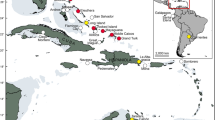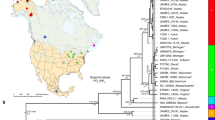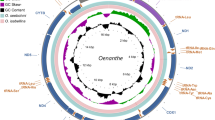Abstract
The origin of the ratites, large flightless birds from the Southern Hemisphere, along with their flighted sister taxa, the South American tinamous, is central to understanding the role of plate tectonics in the distributions of modern birds and mammals. Defining the dates of ratite divergences is also critical for determining the age of modern avian orders1,2,3,4,5,6. To resolve the ratite phylogeny and provide biogeographical data to examine these issues, we have here determined the first complete mitochondrial genome sequences of any extinct taxa— two New Zealand moa genera—along with a 1,000-base-pair sequence from an extinct Madagascan elephant-bird. For comparative data, we also generated 12 kilobases of contiguous sequence from the kiwi, cassowary, emu and two tinamou genera. This large dataset allows statistically precise estimates of molecular divergence dates and these support a Late Cretaceous vicariant speciation of ratite taxa, followed by the subsequent dispersal of the kiwi to New Zealand. This first molecular view of the break-up of Gondwana provides a new temporal framework for speciation events within other Gondwanan biota and can be used to evaluate competing biogeographical hypotheses.
This is a preview of subscription content, access via your institution
Access options
Subscribe to this journal
Receive 51 print issues and online access
$199.00 per year
only $3.90 per issue
Buy this article
- Purchase on Springer Link
- Instant access to full article PDF
Prices may be subject to local taxes which are calculated during checkout


Similar content being viewed by others
References
Cracraft, J. Phylogeny and evolution of the ratite birds. Ibis 116, 494–521 (1974).
Sibley, C. G. & Ahlquist, J. E. Phylogeny and Classification of Birds (Yale Univ. Press, London, 1990).
Cooper, A. et al. Independent origins of the New Zealand moas and kiwis. Proc. Natl Acad. Sci. USA 89, 8741–8744 (1992).
Cooper, A. & Penny, D. Mass survival of birds across the Cretaceous–Tertiary: Molecular evidence. Science 275, 1109–1113 (1997).
Feduccia, A. The Origin and Evolution of Birds (Harvard Univ. Press, Cambridge, Massachusetts, 1997).
Van Tuinen, M., Sibley, C. & Hedges, S. B. Phylogeny and biogeography of ratite birds inferred from DNA sequences of the mitochondrial ribosomal genes. Mol. Biol. Evol. 15, 370–376 (1998).
Olson, S. L. in Avian Biology Vol. VIII (eds Farner, D. S., King, J. R. & Parkes, K. C.) 79–238 (Academic, Orlando, 1985).
Lee, K., Feinstein, J. & Cracraft, J. in Avian Molecular Evolution and Molecular Systematics (ed. Mindell, D.) 173–208 (Academic, New York, 1997).
Houde, P. Ostrich ancestors found in the Northern Hemisphere suggest new hypothesis of ratite origins. Nature 324, 563–565 (1986).
Bledsoe, A. H. A phylogenetic analysis of postcranial skeletal characters of the ratite birds. Ann. Carnegie Mus. 57, 73–90 (1988).
Cooper, A. in Avian Molecular Evolution and Molecular Systematics (ed. Mindell, D.) 345–373 (Academic, New York, 1997).
Handt, O., Krings, M., Ward, R. H. & Pääbo, S. The retrieval of ancient human DNA sequences. Am. J. Hum. Genet. 59, 368–376 (1996).
Krings, M. et al. Neandertal DNA sequence and the origin of modern humans. Cell 90, 19–30 (1997).
Cooper, A. in Ancient DNA (eds Herrmann, B. & Hummel, S.) 149–165 (Springer, New York, 1993).
Boles, W. E. Hindlimb proportions and locomotion of Emuarius gidju (Patterson & Rich, 1987) (Aves: Casuariidae). Memoirs of the Queensland Museum 41, 235–240 (1997).
Lawver, L. A., Royer, J-Y., Sandwell, D. T. & Scotese, C. R. in Geological Evolution of Antarctica (eds Thomson, M. R. A., Crame, J. A. & Thomson, J. W.) 533–539 (Cambridge Univ. Press, Cambridge, 1991).
Cooper, R. A. & Millener, P. R. The New Zealand biota: Historical background and new research. Trends Ecol. Evol. 8, 429–433 (1993).
Fleming, C. A. The Geological History of New Zealand and its Life (Univ. Auckland Press, Auckland, 1979).
Stevens, G. R. Lands in collision. N. Z. Dept Sci. Ind. Res. Inf. Serv. 161 (1985).
Storch, G. in The Africa–South America Connection (eds George, W. & Lavocat, R.) 76–86 (Clarendon, Oxford, 1993).
Martin, P. G. & Dowd, J. M. Using sequences of rbcL to study phylogeny and biogeography of Nothofagus species. Aust. Syst. Bot. 6, 441–447 (1993).
Herzer, R. et al. Reinga Basin and its margins. N. Z. J. Geol. Geophys. 40, 425–451 (1997).
Sauer, E. G. F. Ratite eggshells and phylogenetic questions. Bonn Zool. Beitr. 23, 3–48 (1972).
Krause, D. W., Prasad, G. V. R., von Koenigswald, W., Sahni, A. & Grine, F. E. Cosmopolitanism among Gondwanan Late Cretaceous mammals. Nature 390, 504–507 (1997).
Sampson, S. D. et al. Predatory dinosaur remains from Madagascar: Implications for the Cretaceous biogeography of Gondwana. Science, 280, 1048–1051 (1998).
Cooper, A. & Poinar, H. Ancient DNA: Do it right or not at all. Science 289, 1139 (2000).
Swofford, D. L. PAUP*. Phylogenetic Analysis Using Parsimony (*and Other Methods) (Sinauer, Sunderland, Massachusetts, 1999).
Huelsenbeck, J. P., Hillis, D. M. & Jones R. in Molecular Zoology: Strategies and Protocols (eds Ferraris, J. & Palumbi, S.) 19–45 (Wiley, New York, 1996).
Rambaut, A. & Bromham, L. Estimating divergence dates from molecular sequences. Mol. Biol. Evol. 15, 442–448 (1998).
Felsenstein, J. Evolutionary trees from DNA sequences: a maximum likelihood approach. J. Mol. Evol. 17, 368–376 (1981).
Acknowledgements
We thank W. Boles, R. Cooper, R. Herzer, P. Houde, C. Mourer-Chauviré, D. Penny and T. Worthy for valuable comments, and M. Sorenson for allowing us access to unpublished rhea and ostrich sequences. We are grateful to T. Worthy and the staff of the Museum of New Zealand for the moa samples. Modern samples were kindly provided by A. C. Wilson (deceased), M. Potter and M. Braun, and laboratory space by R. Thomas, J. Bertranpetit and the Oxford University Museum. A.C. was supported by the NERC, the Leverhulme Fund, the New Zealand Marsden Fund and the Royal Society. C.L.F. was supported by the Comissionat per a Universitats i Recerca (Catalan Autonomous Government), and A.R. was supported by the Wellcome Trust.
Author information
Authors and Affiliations
Corresponding author
Supplementary information
Rights and permissions
About this article
Cite this article
Cooper, A., Lalueza-Fox, C., Anderson, S. et al. Complete mitochondrial genome sequences of two extinct moas clarify ratite evolution. Nature 409, 704–707 (2001). https://doi.org/10.1038/35055536
Received:
Accepted:
Issue Date:
DOI: https://doi.org/10.1038/35055536
This article is cited by
-
Past and future potential range changes in one of the last large vertebrates of the Australian continent, the emu Dromaius novaehollandiae
Scientific Reports (2021)
-
Improving the performance of Bayesian phylogenetic inference under relaxed clock models
BMC Evolutionary Biology (2020)
-
Out of India, thrice: diversification of Asian forest scorpions reveals three colonizations of Southeast Asia
Scientific Reports (2020)
-
Comparison of the biogeographic origin of three terrestrial arthropod groups in the Socotra Archipelago (Yemen)
Rendiconti Lincei. Scienze Fisiche e Naturali (2020)
-
‘Paralysed by anxiety’: researchers speak about life in troubled ancient-DNA lab
Nature (2019)
Comments
By submitting a comment you agree to abide by our Terms and Community Guidelines. If you find something abusive or that does not comply with our terms or guidelines please flag it as inappropriate.



